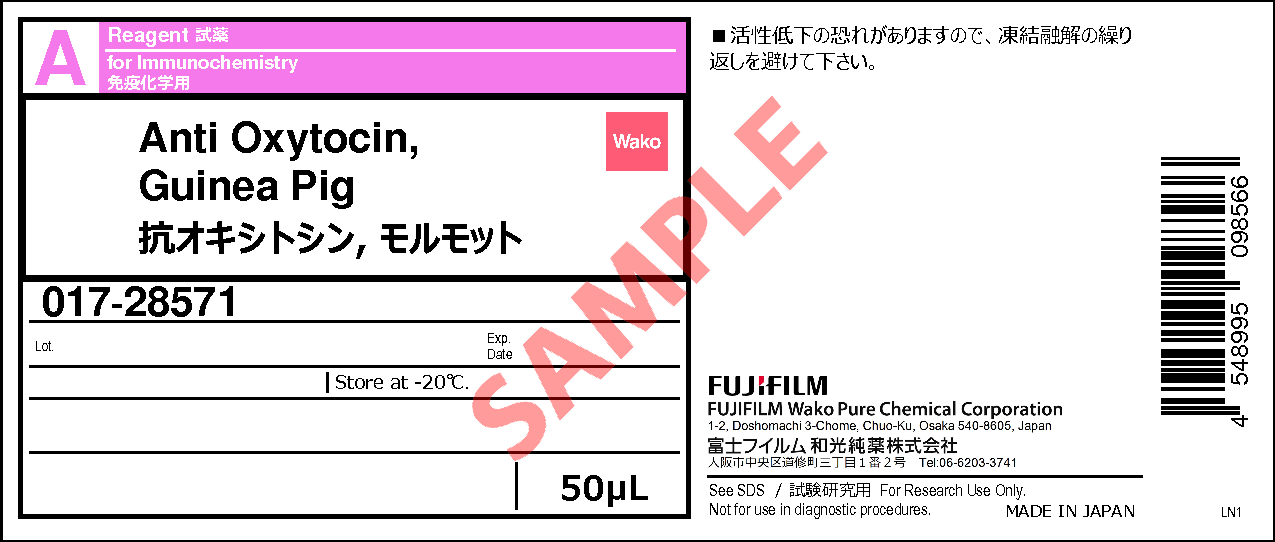Anti Oxytocin, Guinea Pig
- for Immunochemistry
- Manufacturer :
- FUJIFILM Wako Pure Chemical Corporation
- Storage Condition :
- Keep at -20 degrees C.
- Structural Formula
- Label
- Packing
- SDS
|
Comparison
|
Product Number
|
Package Size
|
Price
|
Availability
|
Certificate of Analysis
|
Purchase |
|---|---|---|---|---|---|---|
|
|
|
50uL
|
|
In stock in Japan |
※Check availability in the US with the distributor.
Document
Product Overview
Oxytocin is a 9-amino acid peptide hormone produced in the paraventricular hypothalamic nucleus and released from the posterior pituitary gland1). Oxytocin promotes uterine contraction and breast milk secretion, as well as being involved in stress relief and the activation of maternal behavior, so it is often referred to as the happiness hormone or the love hormone2). "Anti Oxytocin, Guinea Pig" is a guinea pig polyclonal antibody that reacts with Oxytocin3).
Antibody Information
| Clonality | Polyclonal |
|---|---|
| Antigen | KLH conjugated synthetic peptide (CYIQNCPLG-NH2) |
| Host | Guinea pig |
| Formulation | Antiserum diluted in PBS |
| Conjugate | Unconjugated |
| Cross-reactivity | Human, Mouse, Rat, Bovine |
| Application | Immunohistochemistry (Frozen Section) 1:1,500 |
Protocol (Example)
| 1. Perfusion fixation | Perfuse with sodium citrate/PBS to remove blood, followed by perfusion with 4% PFA. |
|---|---|
| 2. Post-fixation | 4% PFA (24 hours) |
| 3. Immersion in sucrose | 30% Sucrose/PBS (4℃, overnight ~ approximately 2 days) |
| 4. Preparation of frozen sections | After removing sucrose, prepare frozen blocks and cut 30-μm thick sections using a cryostat. |
| 5. Glycine treatment | 25 mM glycine/PBS (approximately 20 minutes) |
| 6. Blocking | 5% normal goat serum in 0.3% Triton X-100/PBS (4℃, overnight) |
| 7. Primary antibody reaction | Anti Oxytocin, Guinea pig (1:1,500), 1% normal goat serum in 0.3% Triton X-100/PBS (4℃, overnight ~ 2 days). |
| 8. Washing | 0.3% TritonX-100/PBS (5 minutes x 3) |
| 9. Secondary antibody reaction | Alexa Fluor® 488 AffiniPure Goat Anti-Guinea Pig IgG (H+L) (1:500) (Jackson ImmunoResearch, Product Number: 106-545-003), 1% normal goat serum in 0.3% Triton X-100/PBS (room temperature, 2 hours) |
| 10. Washing | 0.3% TritonX-100/PBS (5 minutes x 3) |
| 11. Mounting | Store at 4℃ in a dark place. |
Data
Application Data
Immunohistochemistry

Species: Mouse
Site: Paraventricular hypothalamic nucleus
Sample: Frozen section
Antibody concentration: 1:1,500
Data by courtesy of
Dr. Miyata, Department of Applied Biology, Kyoto Institute of Technology
References
- Murphy, D. et al.: J. Neuroendocrinol., 24(4), 539(2012).
The Hypothalamic-Neurohypophyseal System: From Genome to Physiology - Wang, P. et al.: ASN Neuro, 14, (2022).
Neural Functions of Hypothalamic Oxytocin and its Regulation - Miyata, S.: Front. Endocrinol., 8, 275(2017).
Advances in understanding of structural reorganization in the hypothalamic neurosecretory system
FAQ
About protocol
- What secondary antibodies can be used?
- At Fujifilm Wako, the following secondary antibodies have been successfully used:
Alexa Fluor® 488 AffiniPure Goat Anti-Guinea Pig IgG (H+L) (Jackson Immuno Research, Product Number: 106-545-003)
About application
- What animals can this antibody be used for?
- Fujifilm Wako has confirmed that it can be used for humans, mice, rats and bovines. Other species have not been tested.
Overview / Applications
| Outline | Oxytocin is a 9-amino acid peptide hormone produced in the paraventricular hypothalamic nucleus and released from the posterior pituitary gland. Oxytocin promotes uterine contraction and breast milk secretion, as well as being involved in stress relief and the activation of maternal behavior, so it is often referred to as the happiness hormone or the love hormone. Anti Oxytocin, Guinea Pig is a guinea pig polyclonal antibody that reacts with Oxytocin. [Antigen] KLH conjugated synthetic peptide corresponding to the oxytocin [Species cross reactivity] Human, mouse, rat and bovine [Application] Immunohistochemistry (frozen section) 1:1500 |
|---|---|
| Precautions for Use | Avoid repeated freeze and thaw. |
Property
| Appearance | Liquid |
|---|---|
| Composition | Antiserum diluted in PBS |
Manufacturer Information
Alias
- Anti Oxytocin, Guinea Pig Polyclonal Antibody
For research use or further manufacturing use only. Not for use in diagnostic procedures.
Product content may differ from the actual image due to minor specification changes etc.
If the revision of product standards and packaging standards has been made, there is a case where the actual product specifications and images are different.




